![[OpenVMS documentation]](../../images/openvms_doc_banner_top.gif)
|
![[Site home]](../../images/buttons/bn_site_home_off.gif)
![[Send comments]](../../images/buttons/bn_comments_off.gif)
![[Help with this site]](../../images/buttons/bn_site_help_off.gif)
![[How to order documentation]](../../images/buttons/bn_order_docs_off.gif)
![[OpenVMS site]](../../images/buttons/bn_openvms_off.gif)
![[Compaq site]](../../images/buttons/bn_compaq_off.gif)
|
| Updated: 11 December 1998 |
![[OpenVMS documentation]](../../images/openvms_doc_banner_top.gif)
|
![[Site home]](../../images/buttons/bn_site_home_off.gif)
![[Send comments]](../../images/buttons/bn_comments_off.gif)
![[Help with this site]](../../images/buttons/bn_site_help_off.gif)
![[How to order documentation]](../../images/buttons/bn_order_docs_off.gif)
![[OpenVMS site]](../../images/buttons/bn_openvms_off.gif)
![[Compaq site]](../../images/buttons/bn_compaq_off.gif)
|
| Updated: 11 December 1998 |
Guidelines for OpenVMS Cluster Configurations
| Previous | Contents | Index |
Each DSSI interconnect can have up to eight nodes attached; four can be
systems and the rest can be storage devices. Figure 10-8,
Figure 10-9, and Figure 10-10 show a progression from a two-node
DSSI OpenVMS Cluster to a four-node DSSI OpenVMS Cluster.
10.4.1 Two-Node DSSI OpenVMS Cluster
In Figure 10-8, two nodes are connected to four disks by a common DSSI interconnect.
Figure 10-8 Two-Node DSSI OpenVMS Cluster
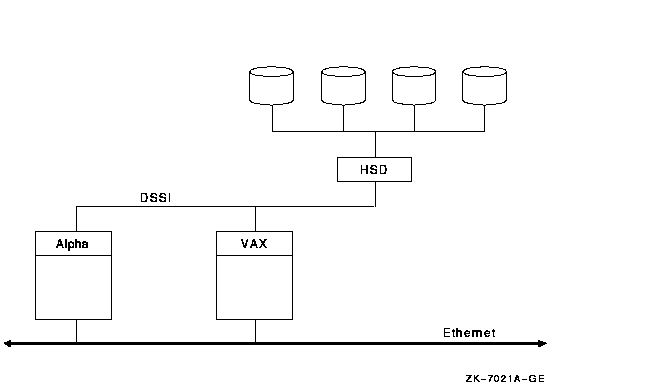
The advantages and disadvantages of the configuration shown in Figure 10-8 include:
If the OpenVMS Cluster in Figure 10-8 required more processing power,
more storage, and better redundancy, this could lead to a configuration
like the one shown in Figure 10-9.
10.4.2 Four-Node DSSI OpenVMS Cluster with Shared Access
In Figure 10-9, four nodes have shared, direct access to eight disks through two DSSI interconnects. Two of the disks are shadowed across DSSI interconnects.
Figure 10-9 Four-Node DSSI OpenVMS Cluster with Shared Access
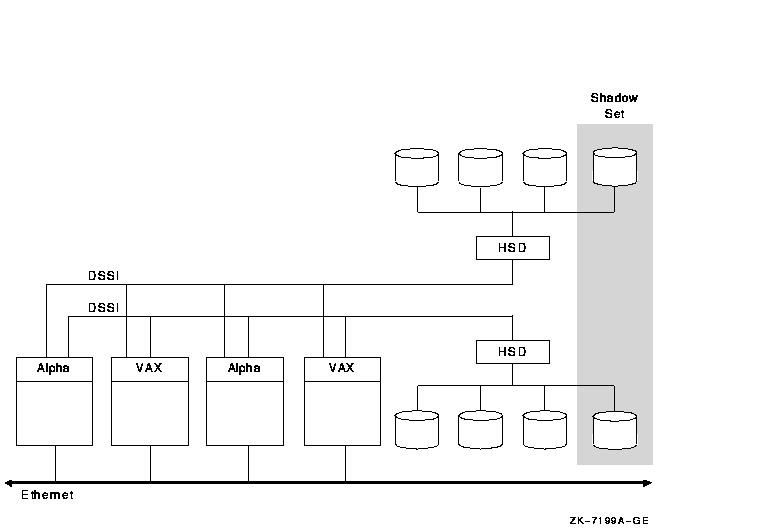
The advantages and disadvantages of the configuration shown in Figure 10-9 include:
If the configuration in Figure 10-9 required more storage, this could
lead to a configuration like the one shown in Figure 10-10.
10.4.3 Four-Node DSSI OpenVMS Cluster with Some Nonshared Access
Figure 10-10 shows an OpenVMS Cluster with 4 nodes and 10 disks. This model differs from Figure 10-8 and Figure 10-9 in that some of the nodes do not have shared, direct access to some of the disks, thus requiring these disks to MSCP served. For the best performance, place your highest-priority data on disks that are directly connected by common DSSI interconnects to your nodes. Volume shadowing across common DSSI interconnects provides the highest availability and may increase read performance.
Figure 10-10 DSSI OpenVMS Cluster with 10 Disks
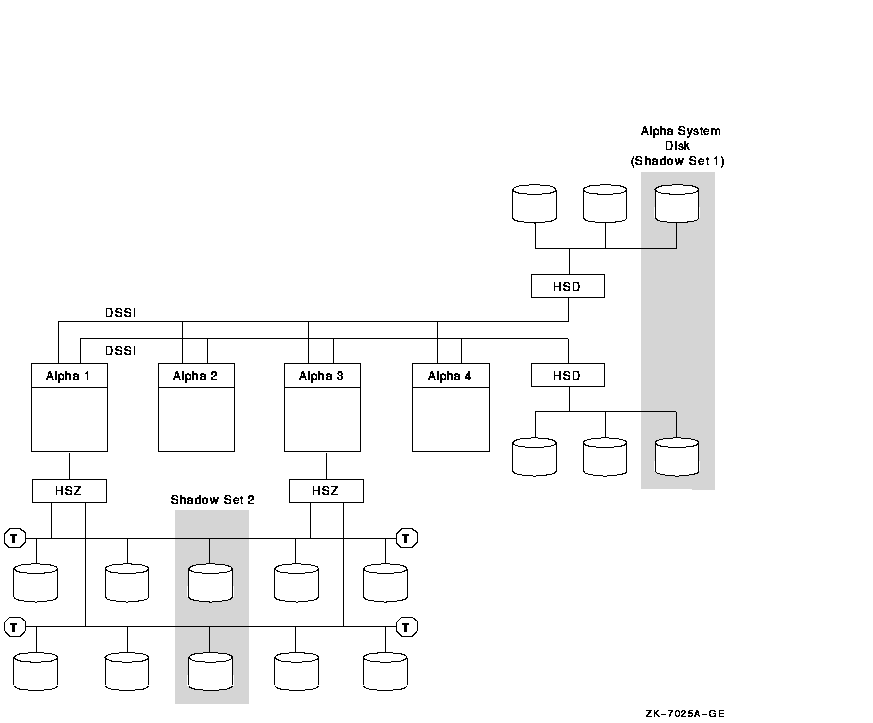
The advantages and disadvantages of the configuration shown in Figure 10-10 include:
Each MEMORY CHANNEL (MC) interconnect can have up to four nodes attached to each MEMORY CHANNEL hub. For two-hub configurations, each node must have two PCI adapters, and each adapter must be attached to a different hub. In a two-node configuration, no hub is required because one of the PCI adapters serves as a virtual hub.
Figure 10-11, Figure 10-12, and Figure 10-13 show a progression from a two-node MEMORY CHANNEL cluster to a four-node MEMORY CHANNEL cluster.
Reference: For additional configuration information
and a more detailed technical summary of how MEMORY CHANNEL works, see
Appendix B.
10.5.1 Two-Node MEMORY CHANNEL Cluster
In Figure 10-11, two nodes are connected by a MEMORY CHANNEL interconnect, a LAN (Ethernet, FDDI, or ATM) interconnect, and a SCSI interconnect.
Figure 10-11 Two-Node MEMORY CHANNEL OpenVMS Cluster
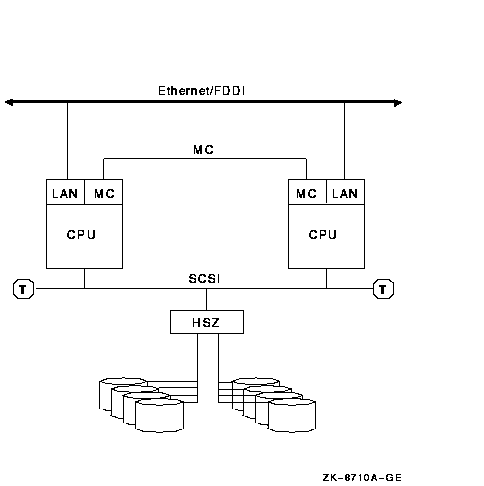
The advantages and disadvantages of the configuration shown in Figure 10-11 include:
If the OpenVMS Cluster in Figure 10-11 required more processing power
and better redundancy, this could lead to a configuration like the one
shown in Figure 10-12.
10.5.2 Three-Node MEMORY CHANNEL Cluster
In Figure 10-12, three nodes are connected by a high-speed MEMORY CHANNEL interconnect, as well as by a LAN (Ethernet, FDDI, or ATM) interconnect. These nodes also have shared, direct access to storage through the SCSI interconnect.
Figure 10-12 Three-Node MEMORY CHANNEL OpenVMS Cluster
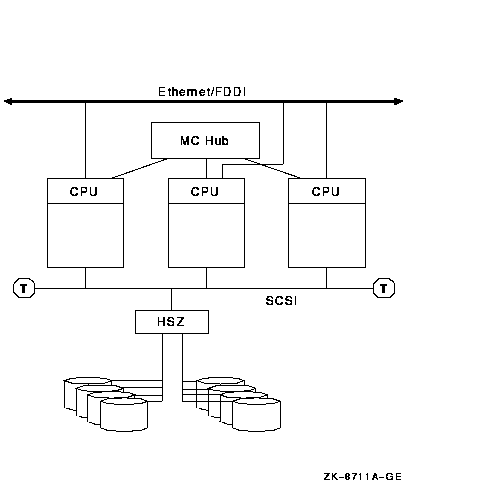
The advantages and disadvantages of the configuration shown in Figure 10-12 include:
If the configuration in Figure 10-12 required more storage, this could
lead to a configuration like the one shown in Figure 10-13.
10.5.3 Four-Node MEMORY CHANNEL OpenVMS Cluster
Figure 10-13, each node is connected by a MEMORY CHANNEL interconnect as well as by a CI interconnect.
Figure 10-13 MEMORY CHANNEL Cluster with a CI Cluster

The advantages and disadvantages of the configuration shown in Figure 10-13 include:
SCSI-based OpenVMS Clusters allow commodity-priced storage devices to be used directly in OpenVMS Clusters. Using a SCSI interconnect in an OpenVMS Cluster offers you variations in distance, price, and performance capacity. This SCSI clustering capability is an ideal starting point when configuring a low-end, affordable cluster solution. SCSI clusters can range from desktop to deskside to departmental and larger configurations.
Note the following general limitations when using the SCSI interconnect:
The figures in this section show a progression from a two-node SCSI
configuration with modest storage to a four-node SCSI hub configuration
with maximum storage and further expansion capability.
10.6.1 Two-Node Fast-Wide SCSI Cluster
In Figure 10-14, two nodes are connected by a 25-m, fast-wide differential (FWD) SCSI bus, with MEMORY CHANNEL (or any) interconnect for internode traffic. The BA356 storage cabinet contains a power supply, a DWZZB single-ended to differential converter, and six disk drives. This configuration can have either narrow or wide disks.
Figure 10-14 Two-Node Fast-Wide SCSI Cluster
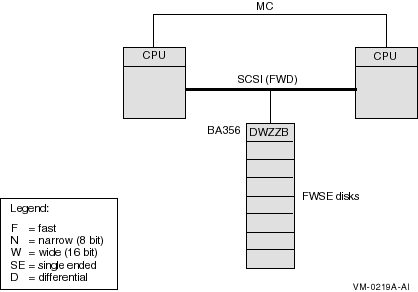
The advantages and disadvantages of the configuration shown in Figure 10-14 include:
If the configuration in Figure 10-14 required even more storage, this
could lead to a configuration like the one shown in Figure 10-15.
10.6.2 Two-Node Fast-Wide SCSI Cluster with HSZ Storage
In Figure 10-15, two nodes are connected by a 25-m, fast-wide differential (FWD) SCSI bus, with MEMORY CHANNEL (or any) interconnect for internode traffic. Multiple storage shelves are within the HSZ controller.
Figure 10-15 Two-Node Fast-Wide SCSI Cluster with HSZ Storage
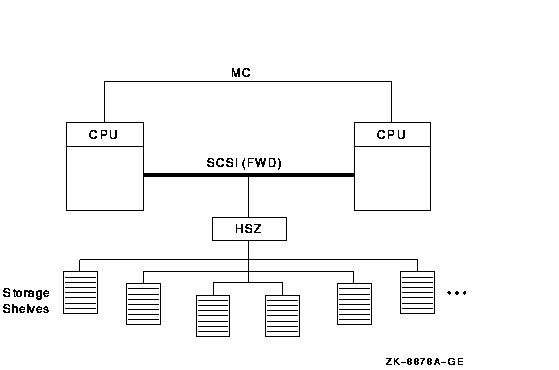
The advantages and disadvantages of the configuration shown in Figure 10-15 include:
In Figure 10-16, three nodes are connected by two 25-m, fast-wide (FWD) SCSI interconnects. Multiple storage shelves are contained in each HSZ controller, and more storage is contained in the BA356 at the top of the figure.
Figure 10-16 Three-Node Fast-Wide SCSI Cluster
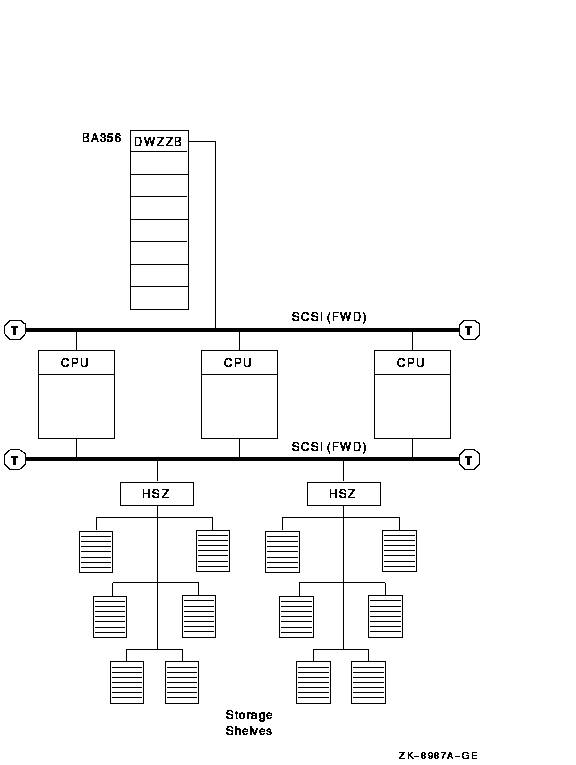
The advantages and disadvantages of the configuration shown in Figure 10-16 include:
Figure 10-17 shows four nodes connected by a SCSI hub. The SCSI hub obtains power and cooling from the storage cabinet, such as the BA356. The SCSI hub does not connect to the SCSI bus of the storage cabinet.
Figure 10-17 Four-Node Ultra SCSI Hub Configuration
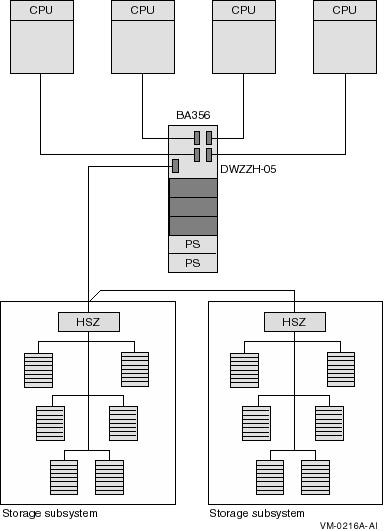
The advantages and disadvantages of the configuration shown in Figure 10-17 include:
The number of satellites in an OpenVMS Cluster and the amount of storage that is MSCP served determine the need for the quantity and capacity of the servers. Satellites are systems that do not have direct access to a system disk and other OpenVMS Cluster storage. Satellites are usually workstations, but they can be any OpenVMS Cluster node that is served storage by other nodes in the OpenVMS Cluster.
Each Ethernet LAN segment should have only 10 to 20 satellite nodes
attached. Figure 10-18, Figure 10-19, Figure 10-20, and
Figure 10-21 show a progression from a 6-satellite LAN to a
45-satellite LAN.
10.7.1 Six-Satellite OpenVMS Cluster
In Figure 10-18, six satellites and a boot server are connected by Ethernet.
Figure 10-18 Six-Satellite LAN OpenVMS Cluster
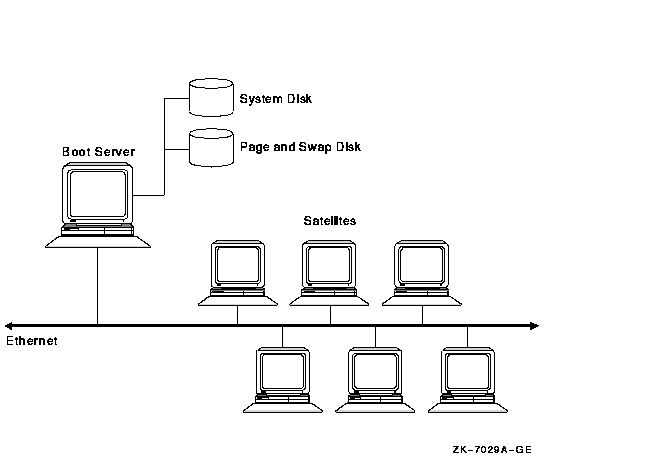
The advantages and disadvantages of the configuration shown in Figure 10-18 include:
If the boot server in Figure 10-18 became a bottleneck, a
configuration like the one shown in Figure 10-19 would be required.
10.7.2 Six-Satellite OpenVMS Cluster with Two Boot Nodes
Figure 10-19 shows six satellites and two boot servers connected by Ethernet. Boot server 1 and boot server 2 perform MSCP server dynamic load balancing: they arbitrate and share the work load between them and if one node stops functioning, the other takes over. MSCP dynamic load balancing requires shared access to storage.
Figure 10-19 Six-Satellite LAN OpenVMS Cluster with Two Boot Nodes
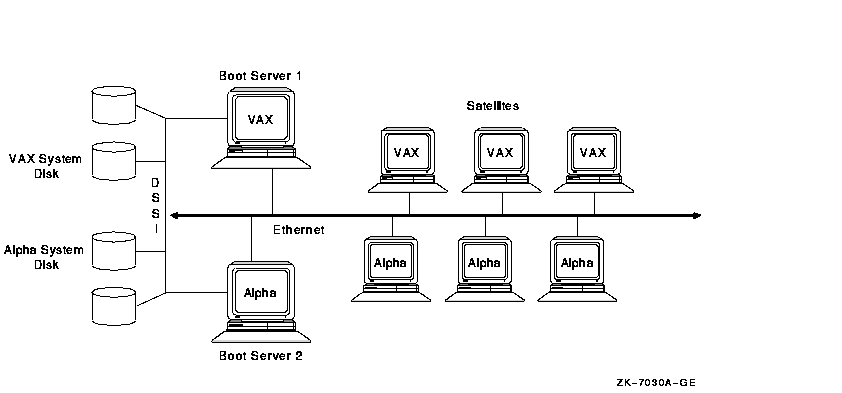
The advantages and disadvantages of the configuration shown in Figure 10-19 include:
If the LAN in Figure 10-19 became an OpenVMS Cluster bottleneck, this
could lead to a configuration like the one shown in Figure 10-20.
10.7.3 Twelve-Satellite LAN OpenVMS Cluster with Two LAN Segments
Figure 10-20 shows 12 satellites and 2 boot servers connected by two Ethernet segments. These two Ethernet segments are also joined by a LAN bridge. Because each satellite has dual paths to storage, this configuration also features MSCP dynamic load balancing.
Figure 10-20 Twelve-Satellite OpenVMS Cluster with Two LAN Segments
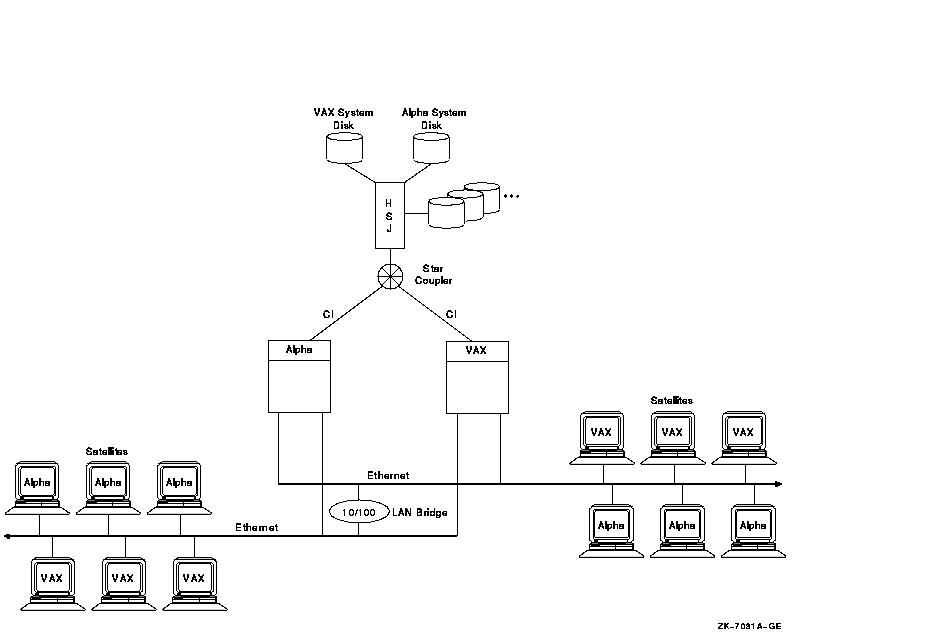
The advantages and disadvantages of the configuration shown in Figure 10-20 include:
If the OpenVMS Cluster in Figure 10-20 needed to grow beyond its
current limits, this could lead to a configuration like the one shown
in Figure 10-21.
10.7.4 Forty-Five Satellite OpenVMS Cluster with FDDI Ring
Figure 10-21 shows a large, 51-node OpenVMS Cluster. The three boot servers, Alpha 1, Alpha 2, and Alpha 3, have two disks: a common disk and a system disk. The FDDI ring has three LAN segments attached. Each segment has 15 workstation satellites as well as its own boot node.
Figure 10-21 Forty-Five Satellite OpenVMS Cluster with FDDI Ring
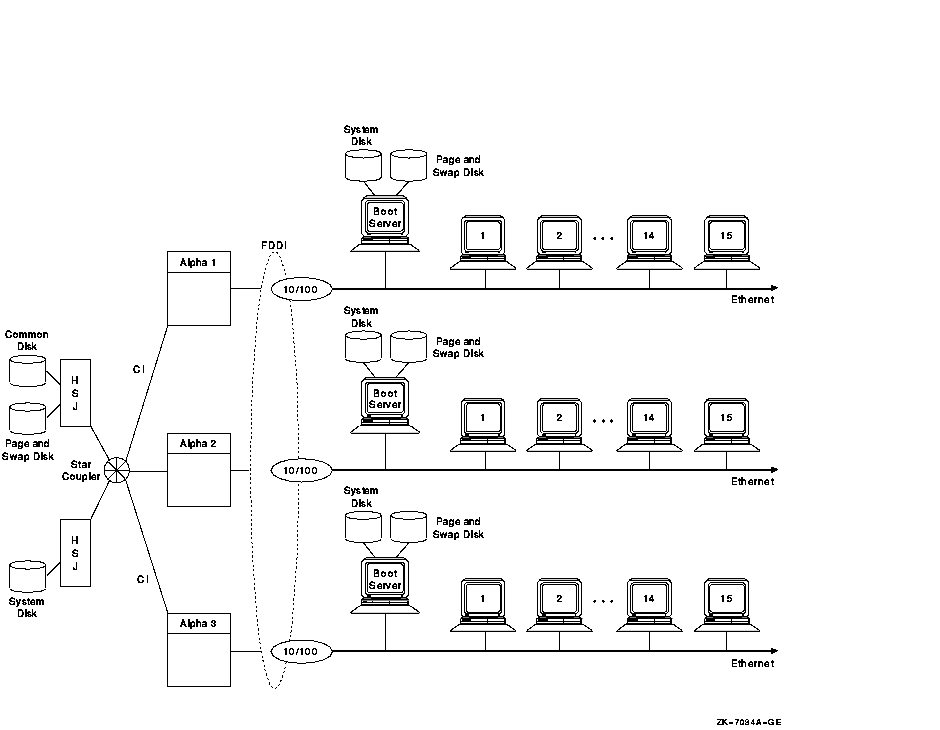
The advantages and disadvantages of the configuration shown in Figure 10-21 include:
Figure 10-22 shows an OpenVMS Cluster configuration that provides high performance and high availability on the FDDI ring.
Figure 10-22 High-Powered Workstation Server Configuration
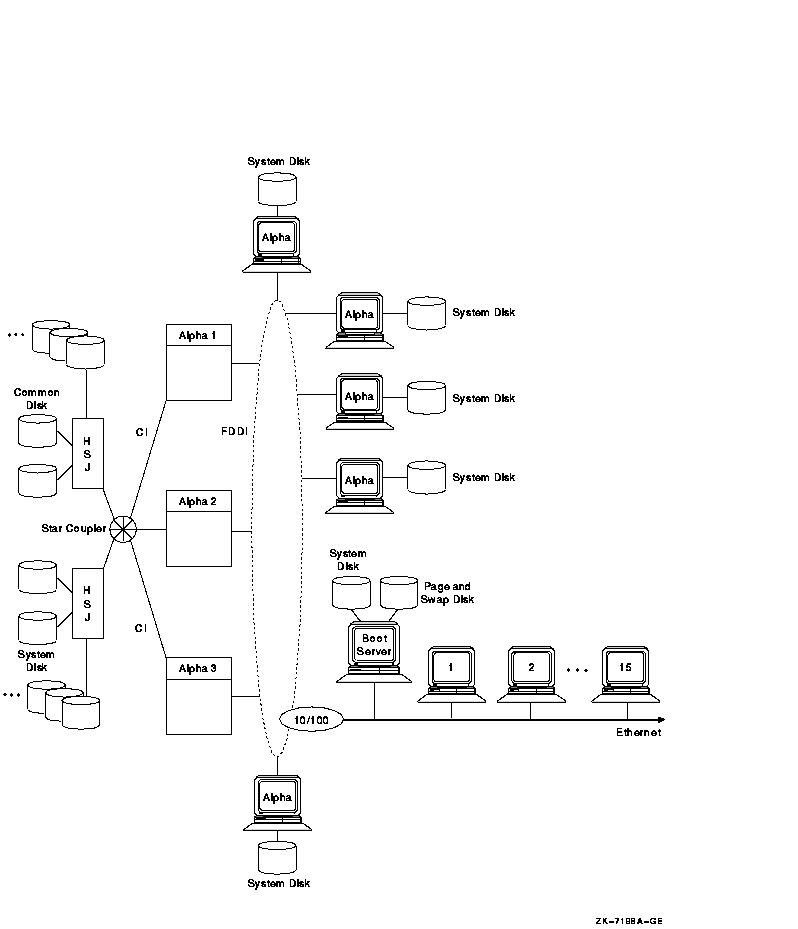
In Figure 10-22, several Alpha workstations, each with its own system
disk, are connected to the FDDI ring. Putting Alpha workstations on the
FDDI provides high performance because each workstation has direct
access to its system disk. In addition, the FDDI bandwidth is higher
than that of the Ethernet. Because Alpha workstations have FDDI
adapters, putting these workstations on an FDDI is a useful alternative
for critical workstation requirements. FDDI is 10 times faster than
Ethernet, and Alpha workstations have processing capacity that can take
advantage of FDDI's speed.
10.7.6 Guidelines for OpenVMS Clusters with Satellites
The following are guidelines for setting up an OpenVMS Cluster with satellites:
You can use bridges between LAN segments to form an extended LAN (ELAN). This can increase availability, distance, and aggregate bandwidth as compared with a single LAN. However, an ELAN can increase delay and can reduce bandwidth on some paths. Factors such as packet loss, queuing delays, and packet size can also affect ELAN performance. Table 10-3 provides guidelines for ensuring adequate LAN performance when dealing with such factors.
| Factor | Guidelines |
|---|---|
| Propagation delay |
The amount of time it takes a packet to traverse the ELAN depends on
the distance it travels and the number of times it is relayed from one
link to another by a bridge or a station on the FDDI ring. If
responsiveness is critical, then you must control these factors.
When an FDDI is used for OpenVMS Cluster communications, the ring latency when the FDDI ring is idle should not exceed 400 ms. FDDI packets travel at 5.085 microseconds/km and each station causes an approximate 1-ms delay between receiving and transmitting. You can calculate FDDI latency by using the following algorithm: Latency = (distance in km) * (5.085 ms/km) + (number of stations) * (1 ms/station) For high-performance applications, limit the number of bridges between nodes to two. For situations in which high performance is not required, you can use up to seven bridges between nodes. |
| Queuing delay |
Queuing occurs when the instantaneous arrival rate at bridges and host
adapters exceeds the service rate. You can control queuing by:
|
| Packet loss |
Packets that are not delivered by the ELAN require retransmission,
which wastes network resources, increases delay, and reduces bandwidth.
Bridges and adapters discard packets when they become congested. You
can reduce packet loss by controlling queuing, as previously described.
Packets are also discarded when they become damaged in transit. You can control this problem by observing LAN hardware configuration rules, removing sources of electrical interference, and ensuring that all hardware is operating correctly. Packet loss can also be reduced by using VMS Version 5.5--2 or later, which has PEDRIVER congestion control. The retransmission timeout rate, which is a symptom of packet loss, must be less than 1 timeout in 1000 transmissions for OpenVMS Cluster traffic from one node to another. ELAN paths that are used for high-performance applications should have a significantly lower rate. Monitor the occurrence of retransmission timeouts in the OpenVMS Cluster. Reference: For information about monitoring the occurrence of retransmission timeouts, see OpenVMS Cluster Systems. |
| Bridge recovery delay |
Choose bridges with fast self-test time and adjust bridges for fast
automatic reconfiguration.
Reference: Refer to OpenVMS Cluster Systems for more information about LAN bridge failover. |
| Bandwidth |
All LAN paths used for OpenVMS Cluster communication must operate with
a nominal bandwidth of at least 10 Mb/s. The average LAN segment
utilization should not exceed 60% for any 10-second interval.
Use FDDI exclusively on the communication paths that have the highest performance requirements. Do not put an Ethernet LAN segment between two FDDI segments. FDDI bandwidth is significantly greater, and the Ethernet LAN will become a bottleneck. This strategy is especially ineffective if a server on one FDDI must serve clients on another FDDI with an Ethernet LAN between them. A more appropriate strategy is to put a server on an FDDI and put clients on an Ethernet LAN, as Figure 10-21 shows. |
| Traffic isolation |
Use bridges to isolate and localize the traffic between nodes that
communicate with each other frequently. For example, use bridges to
separate the OpenVMS Cluster from the rest of the ELAN and to separate
nodes within an OpenVMS Cluster that communicate frequently from the
rest of the OpenVMS Cluster.
Provide independent paths through the ELAN between critical systems that have multiple adapters. |
| Packet size |
You can adjust the NISCS_MAX_PKTSZ system parameter to use the full
FDDI packet size. Ensure that the ELAN path supports a data field of at
least 4474 bytes end to end.
Some failures cause traffic to switch from an ELAN path that supports 4474-byte packets to a path that supports only smaller packets. It is possible to implement automatic detection and recovery from these kinds of failures. This capability requires that the ELAN set the value of the priority field in the FDDI frame-control byte to zero when the packet is delivered on the destination FDDI link. Ethernet-to-FDDI bridges that conform to the IEEE 802.1 bridge specification provide this capability. |
| Previous | Next | Contents | Index |
![[Site home]](../../images/buttons/bn_site_home_off.gif)
![[Send comments]](../../images/buttons/bn_comments_off.gif)
![[Help with this site]](../../images/buttons/bn_site_help_off.gif)
![[How to order documentation]](../../images/buttons/bn_order_docs_off.gif)
![[OpenVMS site]](../../images/buttons/bn_openvms_off.gif)
![[Compaq site]](../../images/buttons/bn_compaq_off.gif)
|
![[OpenVMS documentation]](../../images/openvms_doc_banner_bottom.gif) |
|
Copyright © Compaq Computer Corporation 1998. All rights reserved. Legal |
6318PRO_012.HTML
|